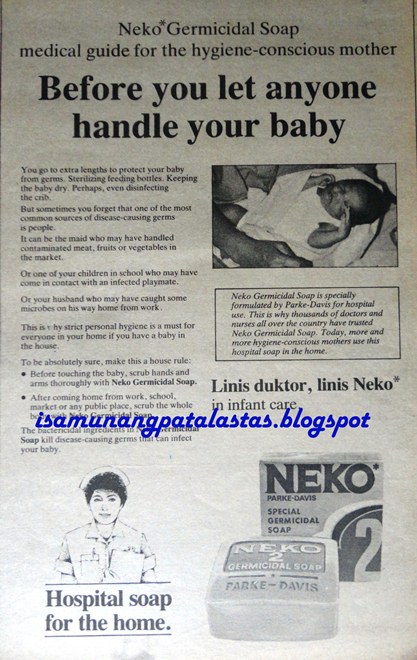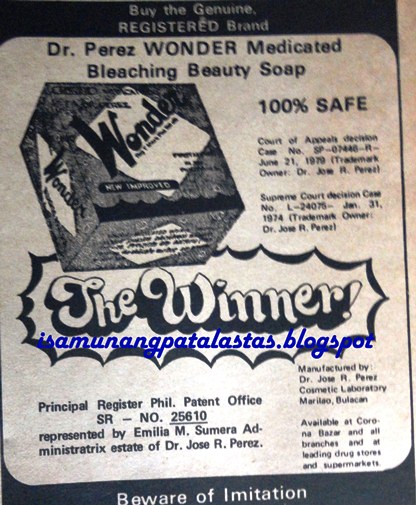 |
| HOW I SURVIVED TEEN-AGE ACNE. A trio of medicated soap essentials popular in the 60s through the 80s. |
Then, as now, the pubescent and teen years are a period
of great anxieties for young Filipinos. The age where his appearance becomes very
important as his social circle expands, is also the time when acnes can begin. In
the 60s and 70s, Filipino teens survived acnes and pimples by depending on affordable
medicated soaps from the boticas—not, mind you, on the expensive, imported anti-acne creams
that were often hard to find.
 |
| DR. KAUFFMAN'S SULPHUR SOAP, 1960 |
DR. KAUFFMAN’S
SULPHUR SOAP
For over a century, sulfur has been employed by western dermatologists to treat a
range of skin conditions including scabies,
warts, dermatitis, and of course, acne. Dr. Carl Ernst Kauffman was a Berlin
University graduate who first concocted sulphur bitters and other derivatives
in the 1830s.
 |
| DR. KAUFFMAN's MEDICINAL SULPHUR SOAP, 1979 |
His inventions were discovered by druggists Aaron P. and Frank L.
Ordway, who would use his formula to make Dr. Kauffman products. The Boston-based
company moved to New York in 1896. Today, A. P. Ordway & Co. still
manufactures DR. KAUFFMAN’S SULPHUR SOAP. Millions of teens have sworn by the
efficacy of this traditional soap in its old-fashioned wrapper, and the iconic
brand continues to be popular worldwide.
 |
| NEKO, very early Philippine ad, Graphic, 1929 |
NEKO SOAP
“The genuine germicidal soap” was available in the
Philippines as an imported brand in the late 1920s, and was advertised in the leading
publications of the day as an ant-deodorant. The NEKO brand is a trademark of
Parke, Davis & Co, once America's oldest and largest drug maker.
 |
| NEKO, HOSPITAL SOAP FOR THE HOME, 1986 |
It has
since been acquired by Warner–Lambert in 1970, then bought by Pfizer in 2000. NEKO’s
active ingredient is mercuric iodide, a disinfectant which helps stop rashes
and acne (course, mercury is now banned in cosmetics). Today, NEKO contains
Trichlorocarbanilide a powerful germicide, in combination with a high quality
soap.
WONDER SOAP
WONDER SOAP was developed way back in 1953 by doctor and
medical researcher Jose Perez of Bulacan, who initially produced a whitening
soap. But he further improved on the formula; aside from bleaching or whitening
the skin, it now also could remove “ pimples, freckles, dandruff, scabies,
itching, head lice(s), rashes, falling of hair, and shallow wrinkles”.
 |
| WONDER SOAP, 1979 |
Thus,
WONDER SOAP was born, which met a measure of success in the 70s, notwithstanding
the petition of Crisanta Y. Gabriel to have the registration covering the trademark
revoked, which she claimed she owned (the Supreme Court ruled in Perez’ favor).
WONDER SOAP is distributed today by Philusa Corp. Its competitor is no less
than C.Y. Gabriel.
SOURCES:
Dr. Kauffman’s Sulphur Soap:
Neko Soap: https://en.wikipedia.org/wiki/Parke-Davis


Sir, a 1997 TVC for Dr. Kauffmann https://www.youtube.com/watch?v=H98kd6hMeWE (CTTO).
ReplyDelete